

Matt Campbell
2026 MG U9 review
3 Hours Ago
Ford and Kia's baby crossovers bring a sporty European flavour to the segment and are very similar on paper... But which is the better bet?

Marketplace Editor
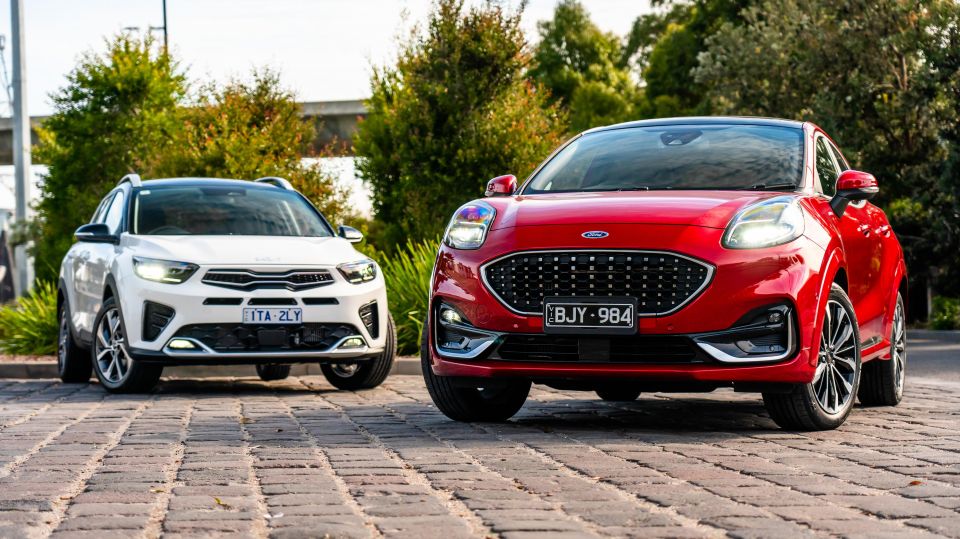

Marketplace Editor
Compact SUVs continue to gain traction in Australia, and manufacturers continue to jack up their city hatchbacks to cater for crossover-hungry consumer tastes.
If you combine the Light SUV and Small SUV segments – which were counted under one tally until recently – there’s about as much sales volume in the compact segments as there are in Medium SUVs and 4×4 utes.
So without further ado, we’ve lined up two top-spec crossovers, both relatively new in the Australian market, both with Euro-centric athletic pitches (to varying degrees) and both from two of Australia’s top five vehicle brands.
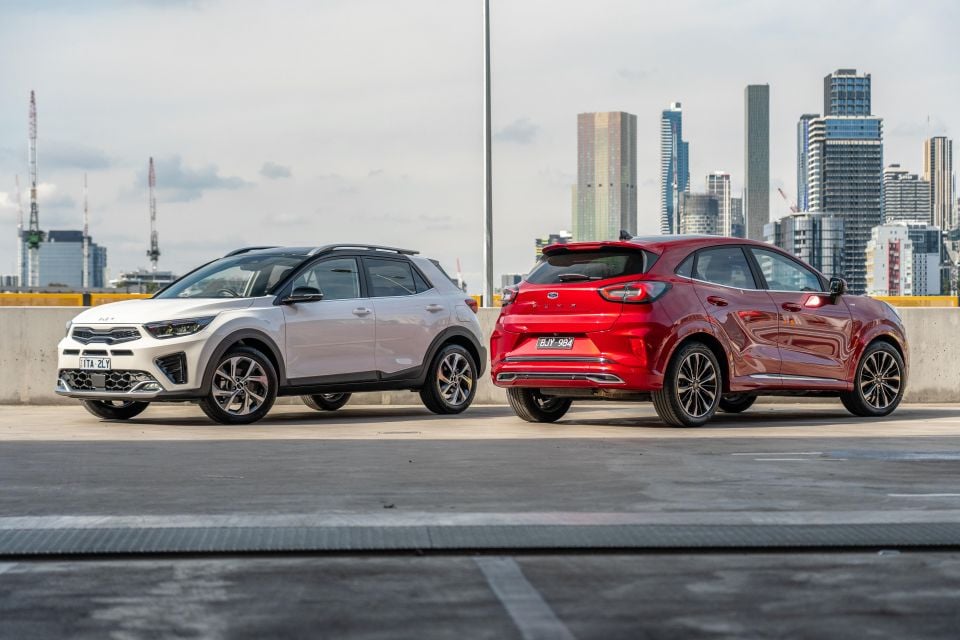
The Ford Puma ST-Line V is one of the more premium offerings, being European-made and offering an extensive suite of high-end features (which you pay for, as you’ll find out).
Meanwhile, the Kia Stonic GT-Line is a strong value play in the segment coming to the table with most of what the target demographic wants combined with sharp drive-away pricing.
Both are based on each brand’s respective light hatchbacks – the Ford Fiesta and Kia Rio – so how far do both go to justify the SUV tax? Further, does the Puma justify its premium pricing, given the flagship Stonic is priced in line with the entry-level Puma grade?
Let the games begin…
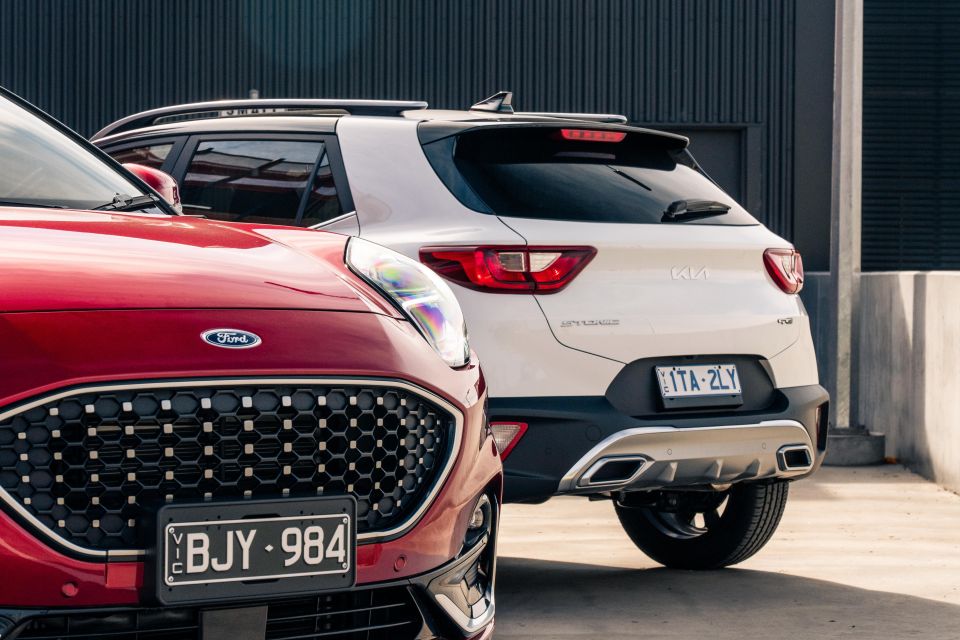
The Kia Stonic GT-Line is by far the more affordable of the two here, priced from $30,490 plus on-road costs, or $32,190 drive-away according to Kia’s online configurator at the time of writing. Two-tone paint is a no-cost option.
Meanwhile, the Ford Puma ST-Line V starts at $35,890 plus on-road costs, though our test car features the optional Park Pack ($990) which adds niceties like adaptive cruise control and front parking sensors, as well as a panoramic sunroof ($2000). The Fantastic Red prestige paint adds a further $650.
Ford doesn’t take a hit on drive-away pricing like Kia does, so without options the Puma ST-Line V carries an ‘estimated’ drive-away price of $40,365 before options, with our test car specified to circa $44,150 drive-away using the online configurator – a whole $12,000 more than the Stonic on test.
That price gulf will buy you almost half of a second Kia Stonic… albeit a base one.
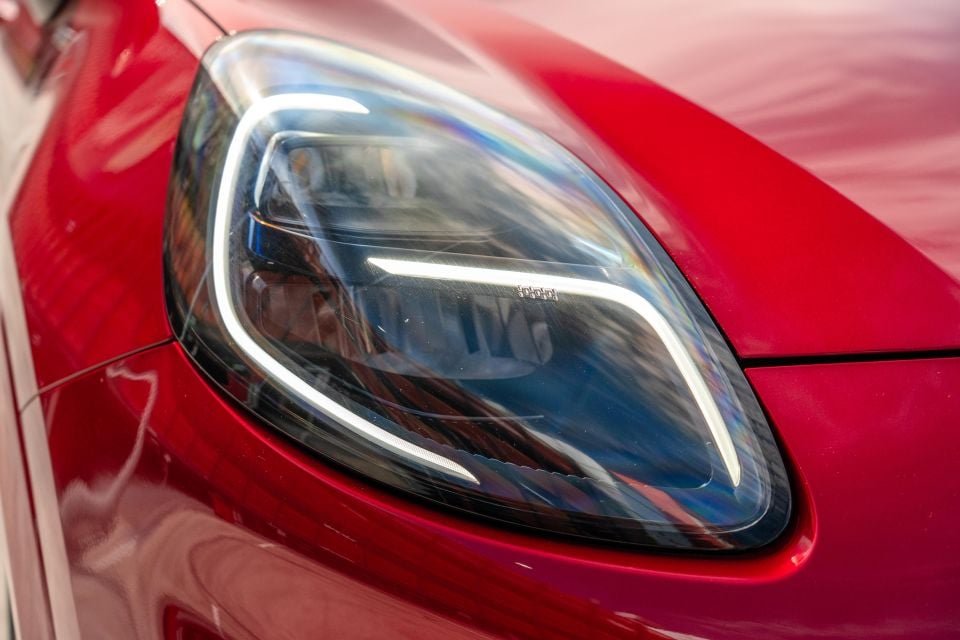
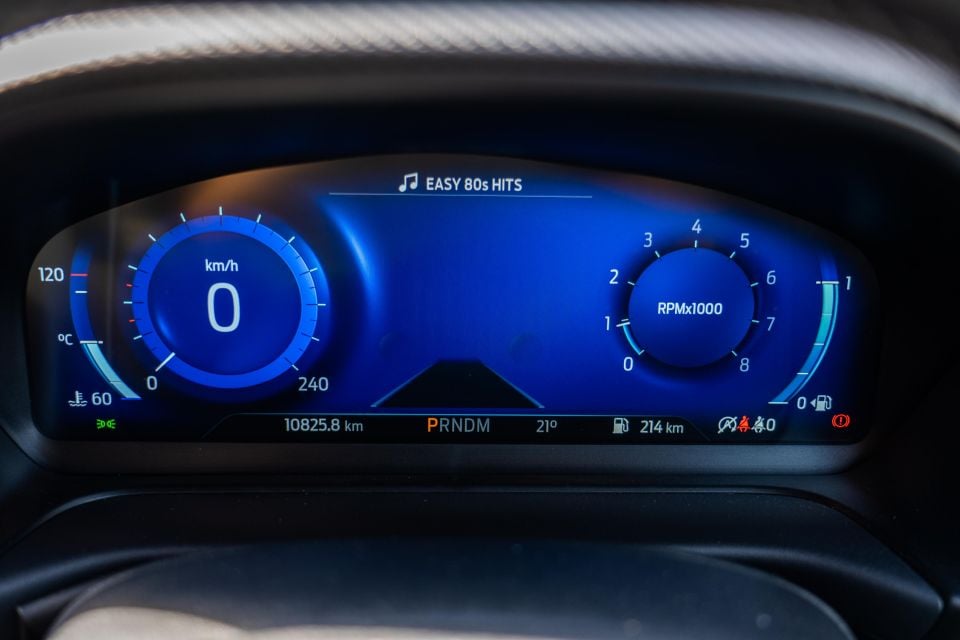
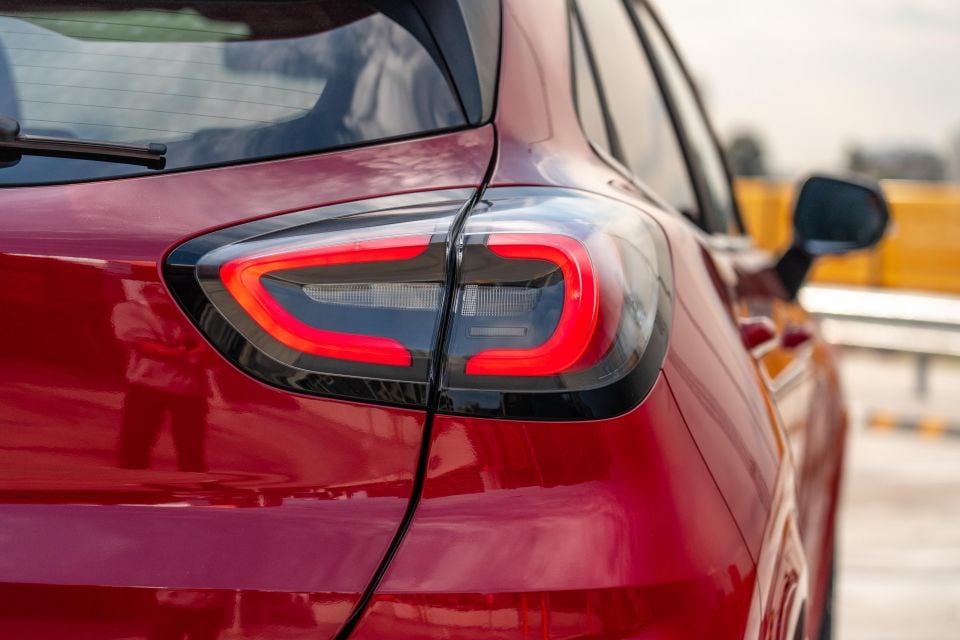
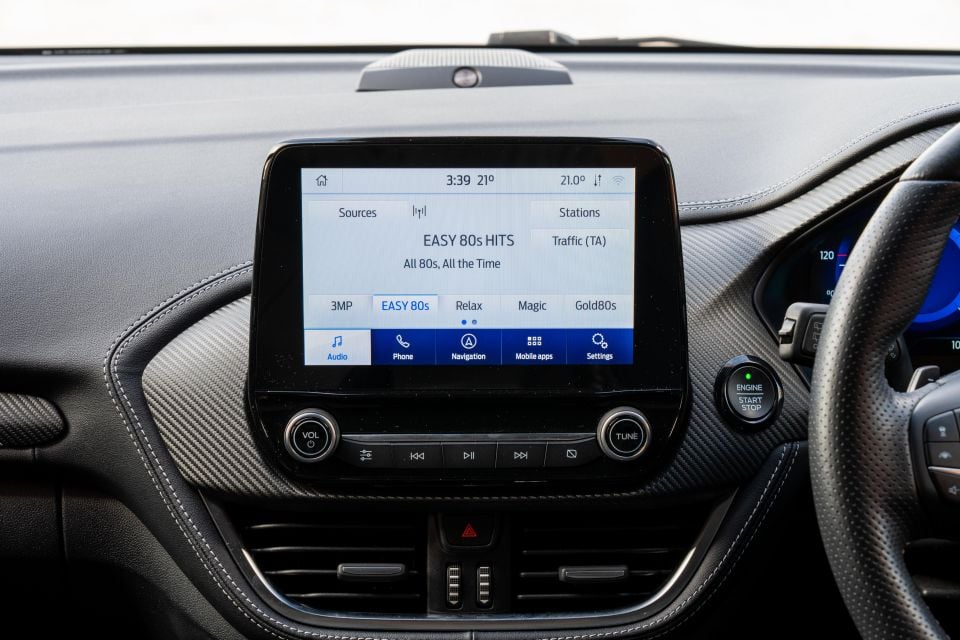
Puma ST-Line V highlights:
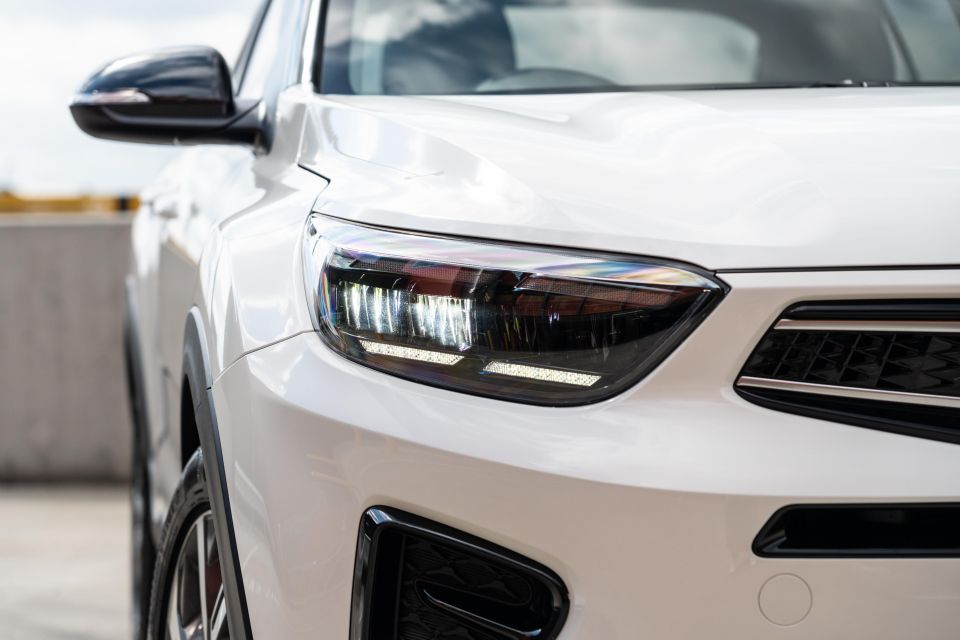
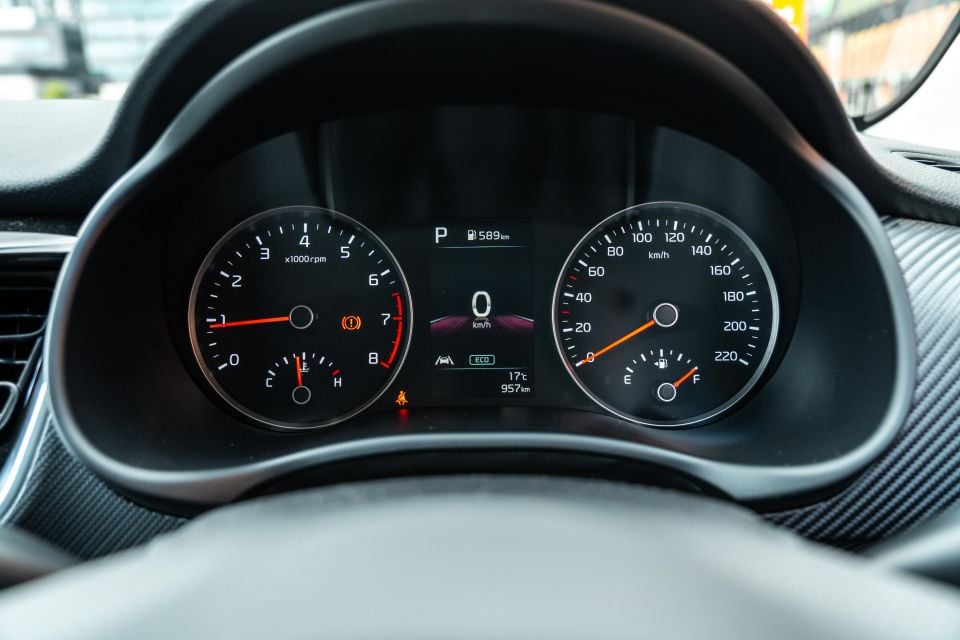
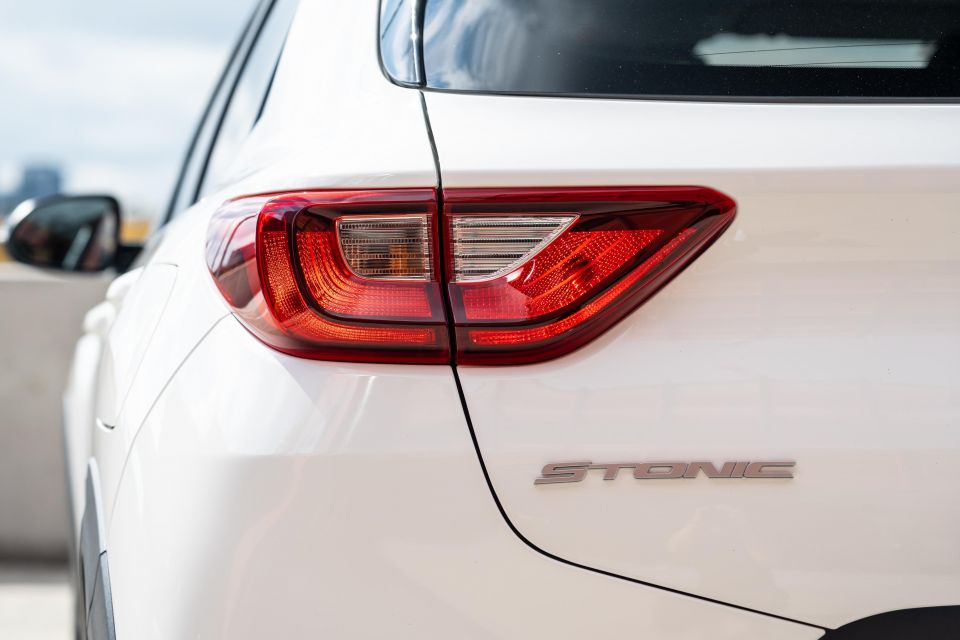
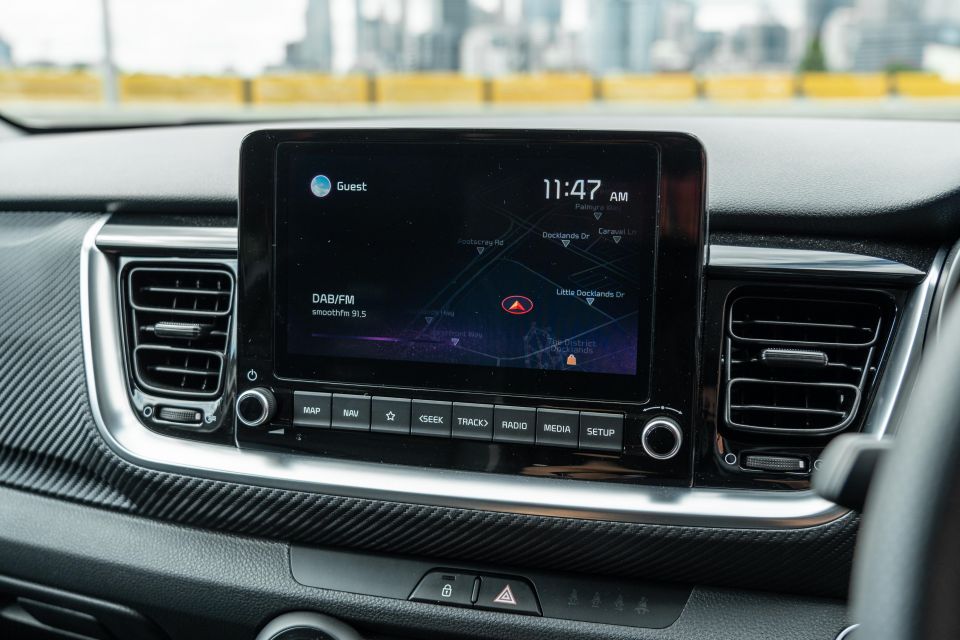
Kia Stonic GT-Line highlights:
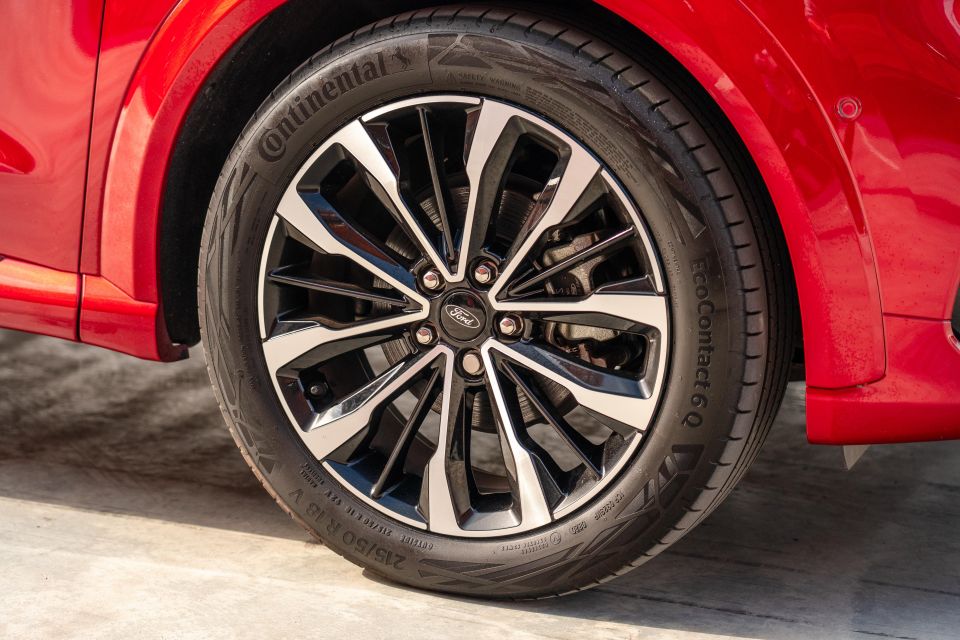
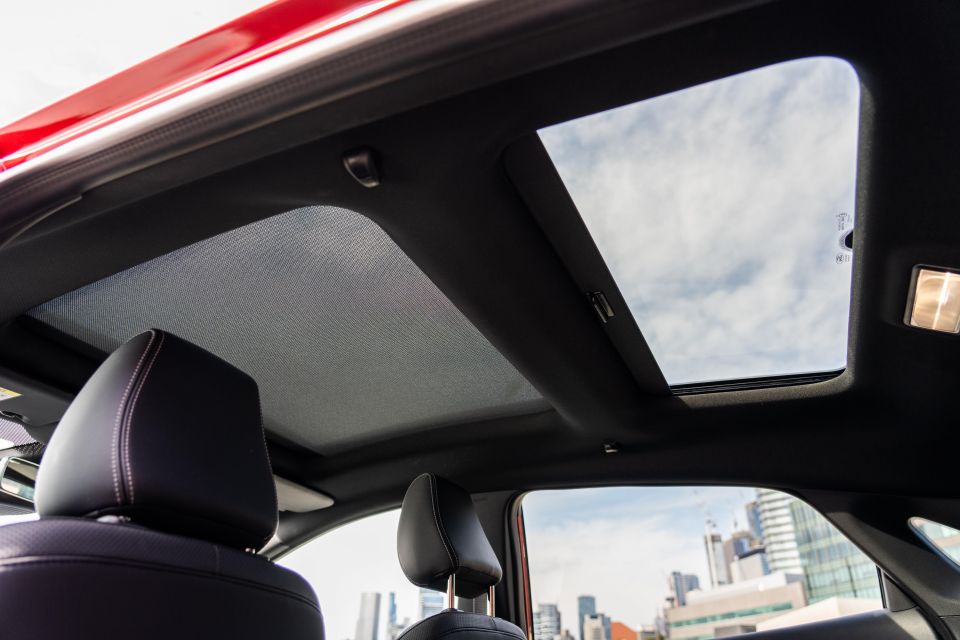

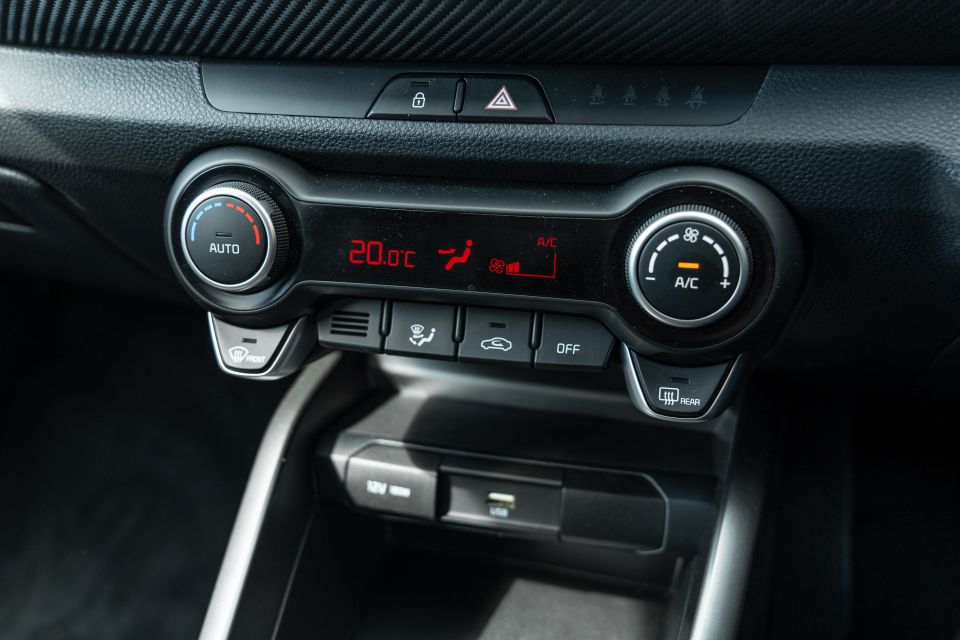
The Ford gets bigger wheels, a digital instrument cluster, LED tail lights, a powered tailgate leatherette upholstery, premium B&O play audio, a wireless smartphone charger and auto high-beam as headline additions over the Kia.
However, the Stonic counters with standard active lane centring assist (known as Lane Following Assist), the standard inclusion of a contrast black roof or powered sunroof (both optional on the Ford).
While not fitted as standard, the Puma’s optional Park Pack as fitted to our tester ($990) adds high-end features like adaptive cruise control with stop/go, active lane centring assist, blind-spot monitoring with rear cross-traffic alert, active park assist, front parking sensors.
All but the lane centring function are not available on the Stonic in Australia, despite stuff like adaptive cruise and blind-spot monitoring being offered in overseas markets.
On paper that leaves the Ford with the longer list of equipment, though when you factor in the $12,000 price difference between the vehicles you see here, the Kia is arguably the better-value play.
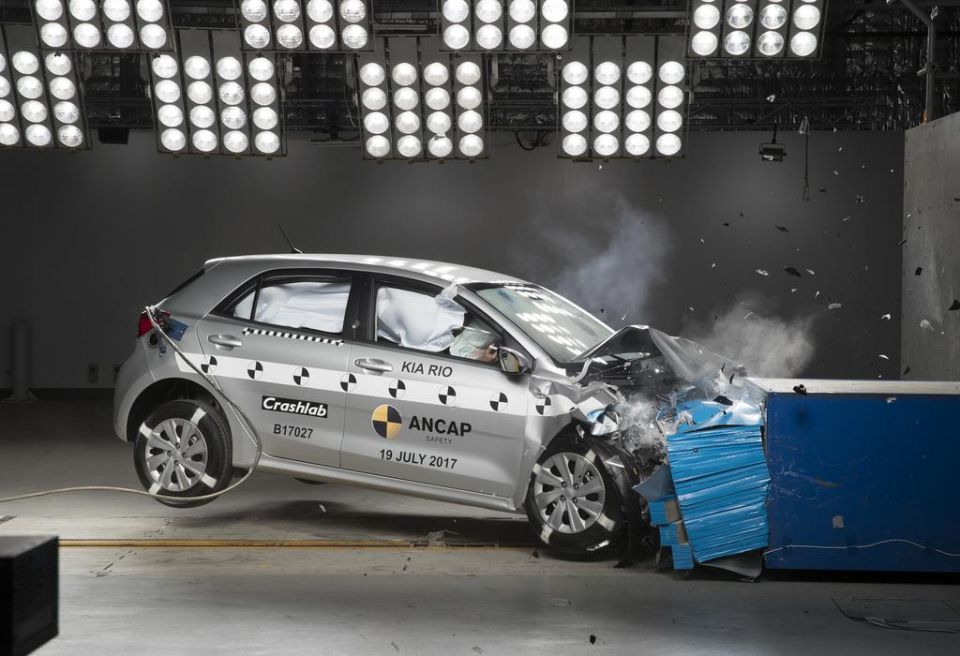
Both vehicles wear five-star ANCAP safety ratings, though the Kia’s rating is older and based on outdated testing criteria.
The Stonic carried over the related Rio hatchback’s 2017-dated five-star rating with testing conducted by ANCAP against the old scoring system. The Rio achieved 35.52 out of 37.00 points, including a frontal offset score of 14.52 out of 16.00 and a perfect side impact rating of 16 out of 16.
Further, the Rio and Stonic weren’t required to have active safety features like AEB and lane-keep assist to make a five-star threshold.

Meanwhile, the Puma’s 2019-stamped five-star score uses more familiar scoring, with 94 per cent for adult occupant protection, 86 per cent for child occupant protection, 77 per cent for vulnerable road user protection and 74 per cent for safety assist.
It’s worth noting that while local Stonic models use the old ANCAP scoring system which was used prior to the local crash tester merging its criteria with Euro NCAP, there is an equivalent Euro NCAP score that’s a better point of comparison to the Puma’s scorecard.
Also dated 2017, the Stonic with Safety Pack (AEB, lane-keep assist like is standard here) scored 93 per cent for adult occupant protection, 84 per cent for child occupant protection, 71 per cent for pedestrian protection and 59 per cent for safety assist. Again, this is based on Kia Rio crash data.
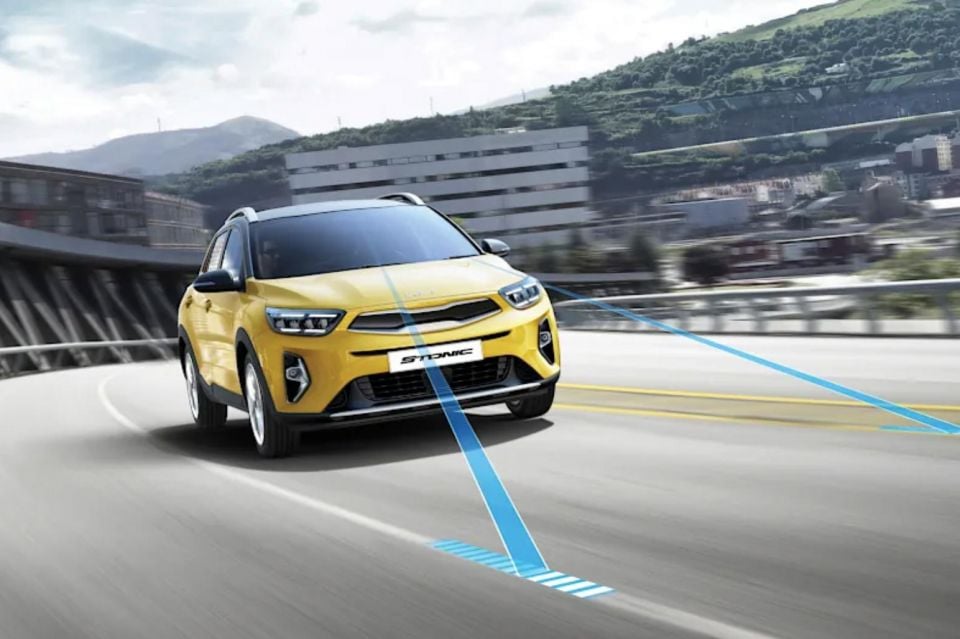
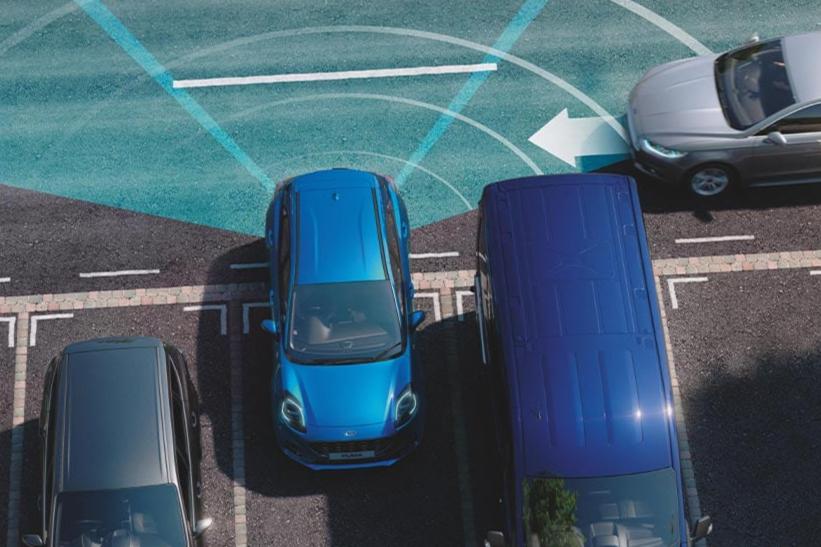
The Ford Puma gets AEB for both city and interurban speeds as standard, as well as lane-keep assist, lane departure warning as well as dual frontal, front-side and side curtain airbags as standard (totalling six).
The Stonic pretty much matches that, with AEB for both city and interurban speeds, lane-keep assist with lane departure warning, and six airbags. It gains Lane Following Assist (active centring) over the Puma as standard equipment.
I’d be inclined to suggest the Ford is theoretically the safer vehicle here, given it scored slightly better against newer, stricter ANCAP/Euro NCAP criteria.
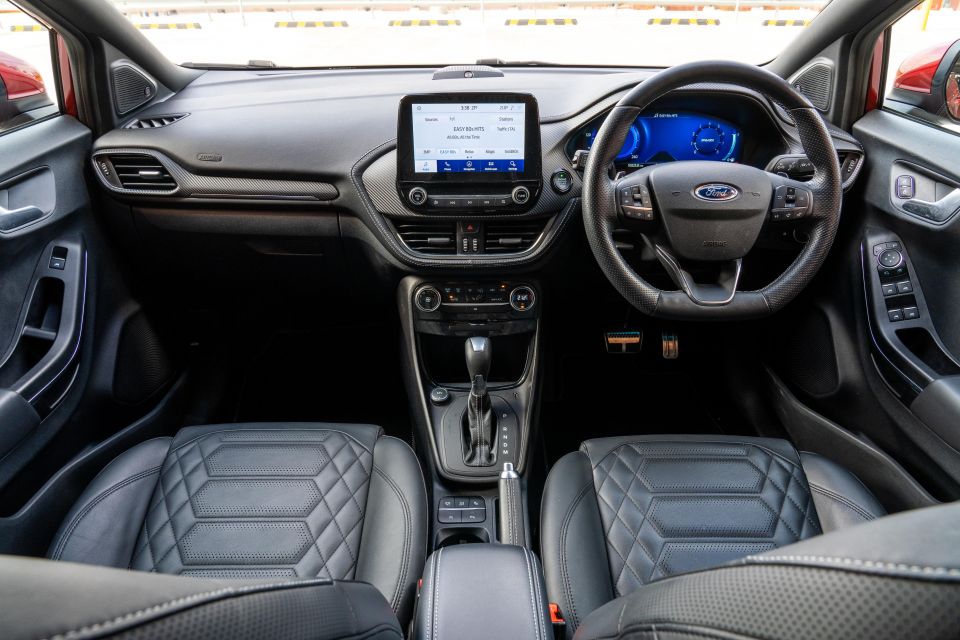
Ford Puma
The top-spec Puma does a fair bit to distinguish itself from its lower-grade siblings, given the bones are largely identical – i.e. no changes in screen size in the model walk or major design changes.
So, the ST-Line V steps it up with a leatherette-trimmed dashboard, quilted Sensico leatherette seats, and metal grey contrast stitching in place of the regular ST-Line’s sportier red topstitching.
If you’ve ever sat in the current Fiesta (only available as an ST in Australia), it’s virtually identical in design and layout, as well as the tall, skinny feel of the body.
Ahead of the driver is a standard 12.3-inch digital instrument cluster behind a chunky flat-bottom sports steering wheel, and the simple centre stack is headlined by an 8.0-inch touchscreen running Ford’s impressive Sync 3 interface.

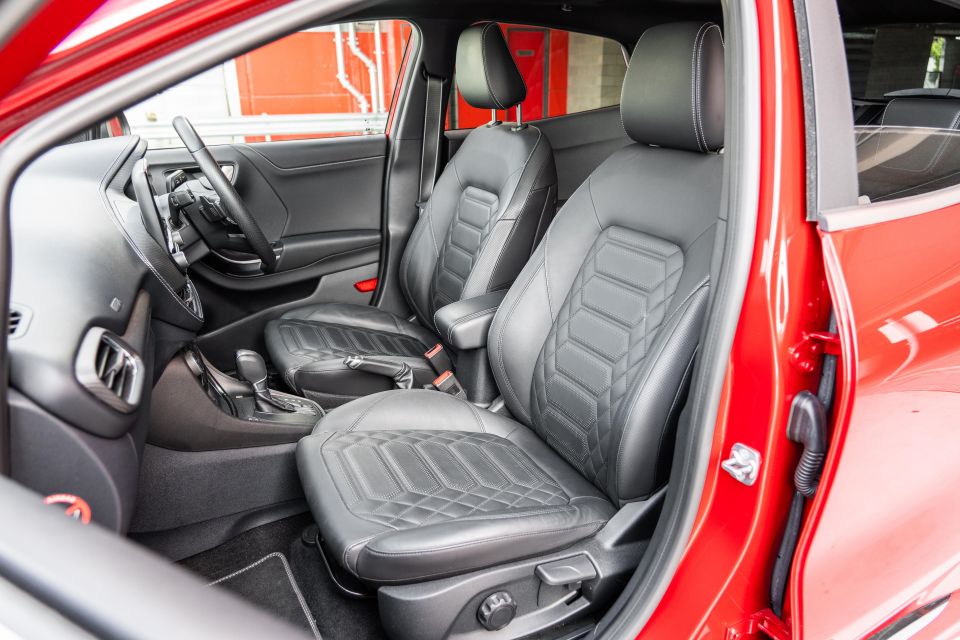
Sync 3 is one of the easiest interfaces to use, offering simple menus and quick response times, as well as being well-featured with DAB radio, embedded satellite navigation, as well as wired Apple CarPlay and Android Auto. It also packs FordPass Connect with online services which means you get live traffic updates as well as app-based remote functions allowing you to check the vehicle’s location, lock/unlock the vehicle, start the engine, and more.
There’s single-zone automatic climate control with physical dials and switches to adjust its various parts, and a wireless phone charger slot ahead of the shifter. The handbrake is a manual type, and there’s a small front-centre armrest which lids a small cubby between the front seats.
Storage is a little lacking up front, with limited space under the centre stack and under the aforementioned armrest, though the door bins are big enough for larger bottles.
Front occupants are treated to comfortable seats, both with manual adjustment, though the aforementioned skinny feel of the Puma’s cabin means you might be nudging elbows in the middle.
Perceived build quality is up there, remember this is a Euro-produced model, and the higher ratio of soft-touch surfaces compared to the Kia makes it feel a cut above in terms of the ambience.
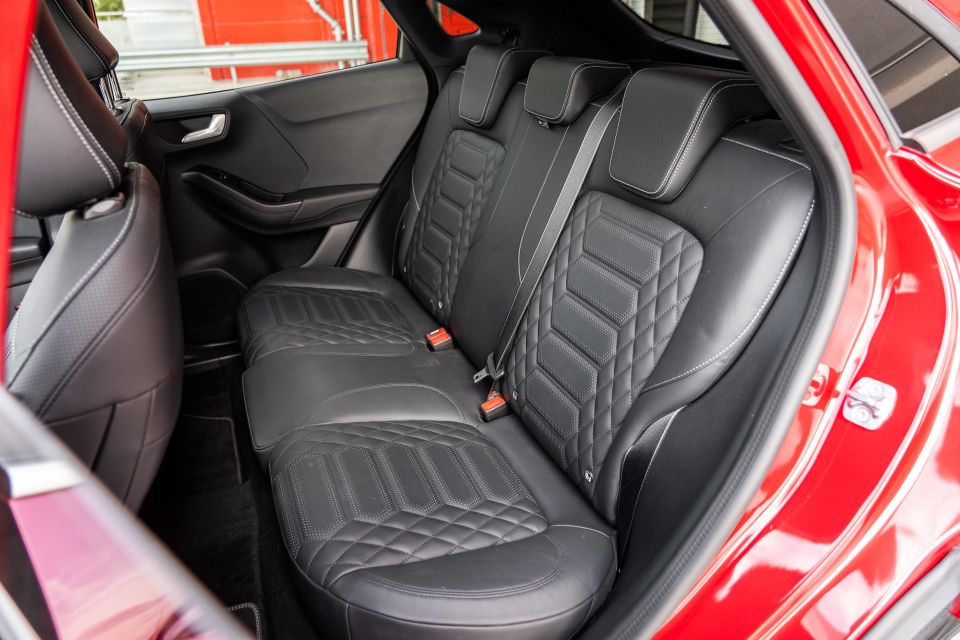
Less impressive is the back seat, which is lacking in space even for average-sized passengers. The Puma has less leg- and kneeroom than the Kia, making this more of an occasional use bench particularly if you’re a taller driver.
Compared to the front row it’s low on amenities too. There’s bottle holders in the doors, but there’s no fold-down armrest, no rear air vents, and also no power outlet – only the latter of which the Kia offers, in fairness. Netted pockets behind the front seats round things out.
The Puma does have ISOFIX anchors on the outboard seats, complemented by top-tether points across all three rear positions.
At least the rear seats get the same quilting treatment as the fronts, so they look the part.
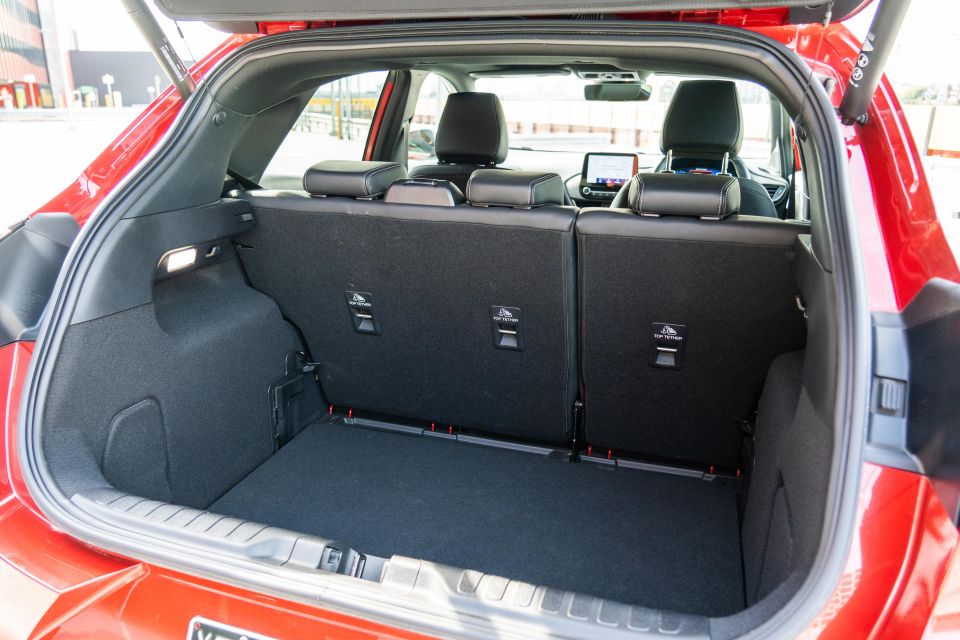
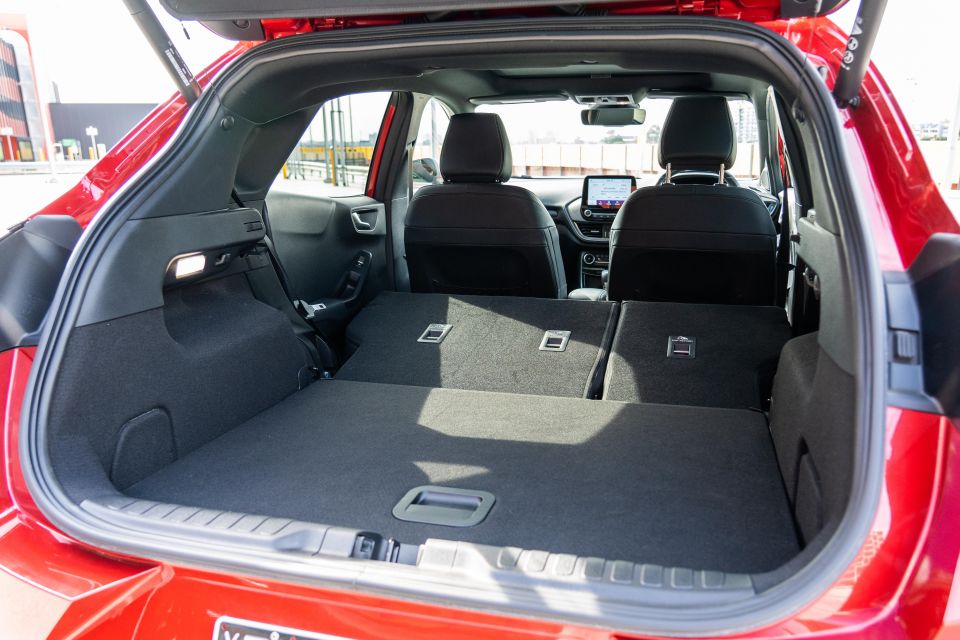

It seems Ford prioritised boot space over rear occupant space, because the Puma’s cargo area is one of the better in the segment and the larger of the two here.
There’s 410 litres of space with the second row up, including the underfloor storage area which has half a MegaBox under the floor. Unlike European models, Aussie-delivered Pumas feature a standard space-saver spare wheel, meaning we don’t get the full 80L multi-purpose compartment.
Fold the second row down and the space expands to 1170L, which is only about 40L more than the Kia in the same configuration.
An advantage here over the Stonic is the inclusion of an adjustable load floor, which means you can either maximise boot space as a five-seater with a low floor, and create an even boot floor when you fold the rear seats.
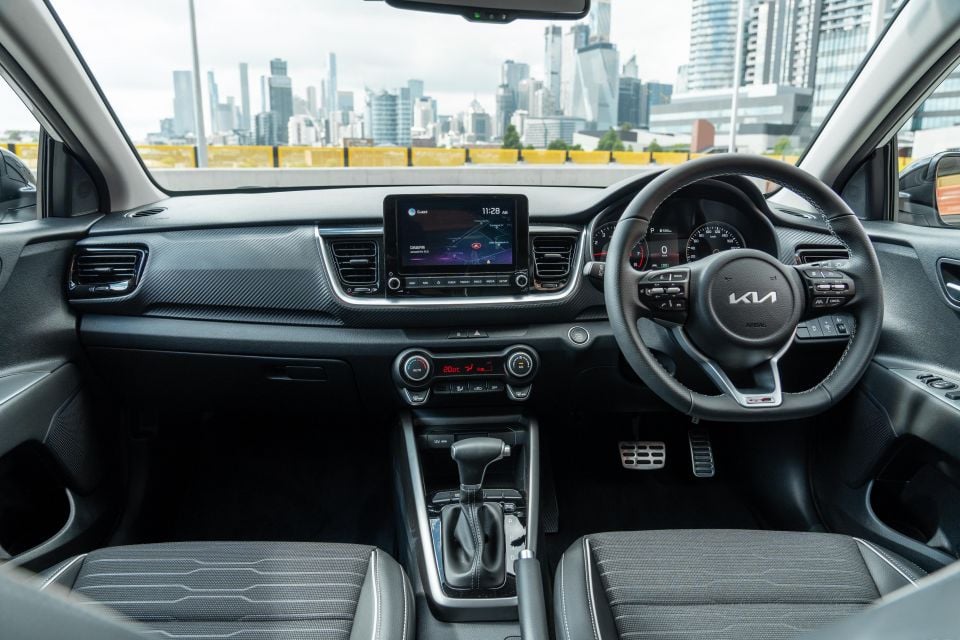
Where expert car reviews meet expert car buying – CarExpert gives you trusted advice, personalised service and real savings on your next new car.
Kia Stonic
Like how the Puma’s cabin basically lifts out the Fiesta’s cockpit, you’d be hard pressed to find any noticeable differences between the Stonic and the Rio hatch on which it’s based.
That means you get an uncluttered dashboard with clean lines and simple switchgear, as well as an 8.0-inch high-resolution running the brand’s latest infotainment and navigation software.
Kia and Hyundai’s native interface is clean and attractive with logical menus and snappy response times, and the Stonic’s standard navigation, DAB radio as well as wired Apple CarPlay and Android Auto means it’s well featured, too. There’s no embedded modem with online services like the Ford, however.
Compared to the Puma you feel an impression of width and airiness, credit to the Stonic’s squarer, boxier proportions. You do, however lack the soft-touch surfaces and leatherette trim on the dashboard – in fact, it’s hard plastics just about everywhere other than the elbow rests.
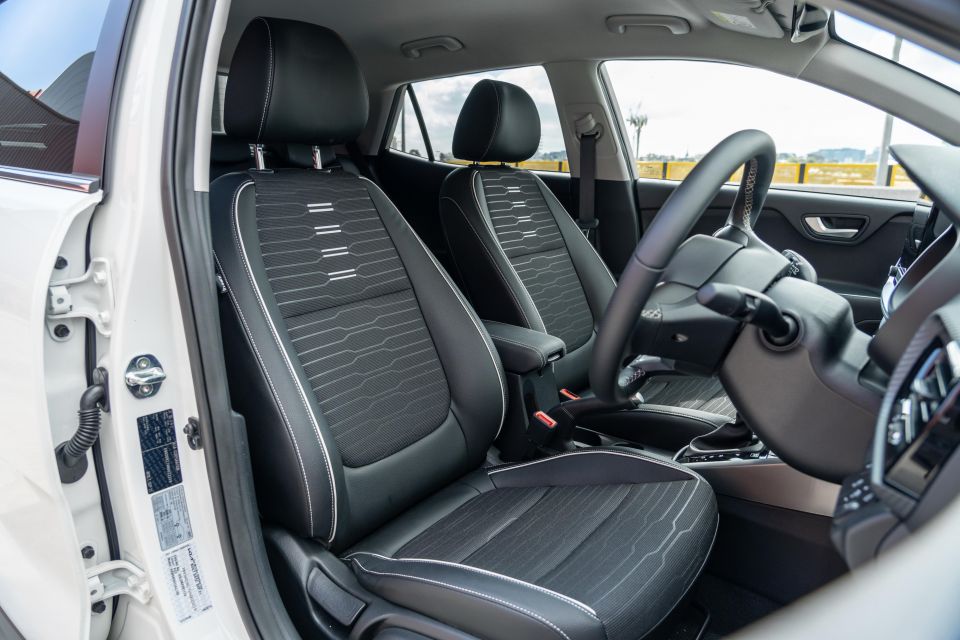

Ahead of the driver there’s analogue dials rather than digital ones, though the conventional tacho and speedo gauges flank a 4.2-inch colour supervision display which shows a digital speedometer readout amongst other menus and functions. It certainly does the job just fine.
The Kia’s storage solutions in the front row are better than the Ford’s, with a deep cubby under the centre stack with an inbuilt shelf, as well as large door bins and a cubby under the front-centre armrest.
Comfort up front is decent if not as good as the Puma, largely down to the seat positioning and range of adjustment that can limit lower back and under thigh support if you’re tall and leggy like me.
The fabric upholstery with leatherette bolsters doesn’t present as nicely as the Puma’s quilted leatherette but they’re less likely to burn your bum in summer and feature a funky design pattern to make them less boring. The flat-bottom GT-Line steering wheel feels very good to hold and arguably is the more attractive tiller, too.
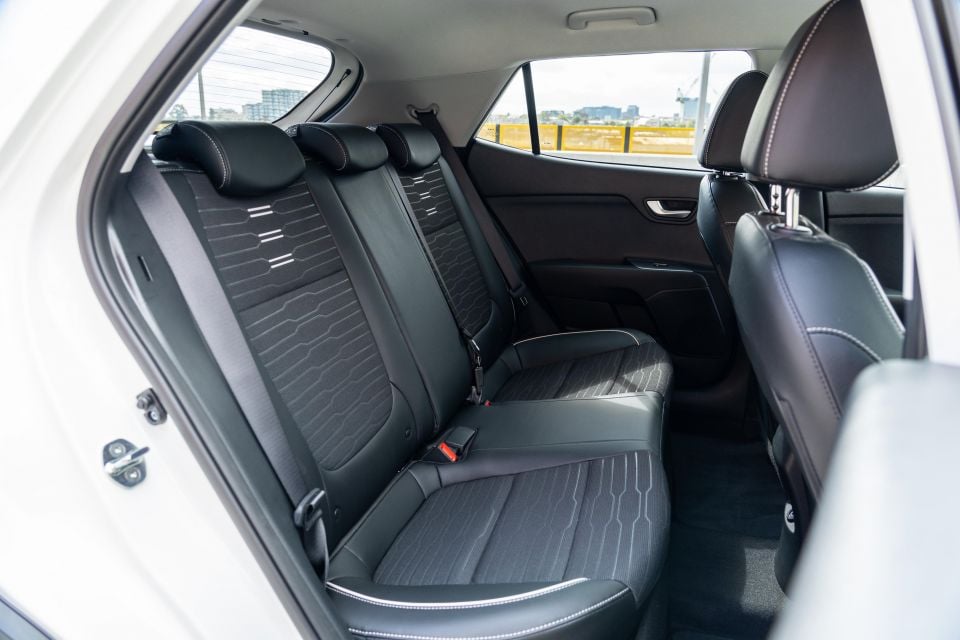
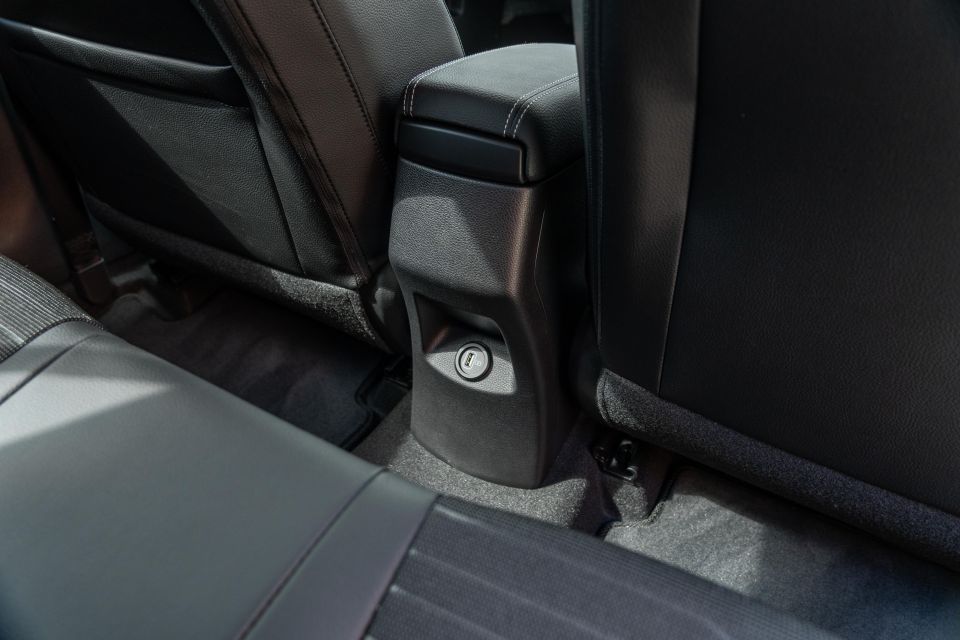
Hop into the second row and the Stonic is noticeably more accommodating than the Ford, with average-sized adults able to sit behind average-sized adults.
It’s a proper four seater with the fifth pew in the centre best left for emergencies. Leg and knee room are good, as is headroom.
Like the Ford, there’s no air vents and no fold-down centre armrest, but there is a USB charging point back there and a map pocket behind the front passenger seat – though not behind the driver’s seat unlike the Puma.
ISOFIX anchors feature on the outboard positions, as is customary, and there’s top-tether points across all three rear seats.

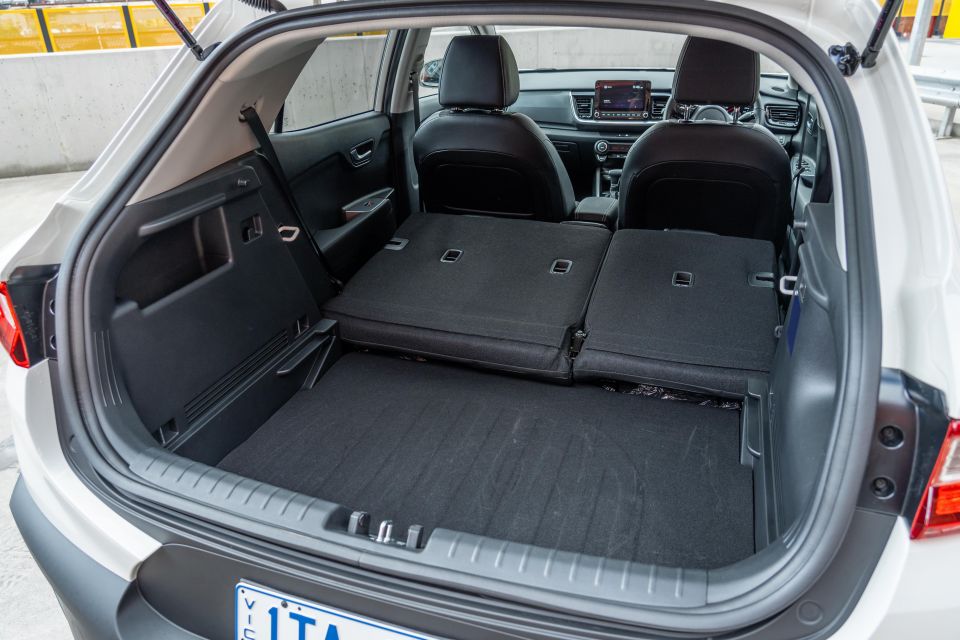
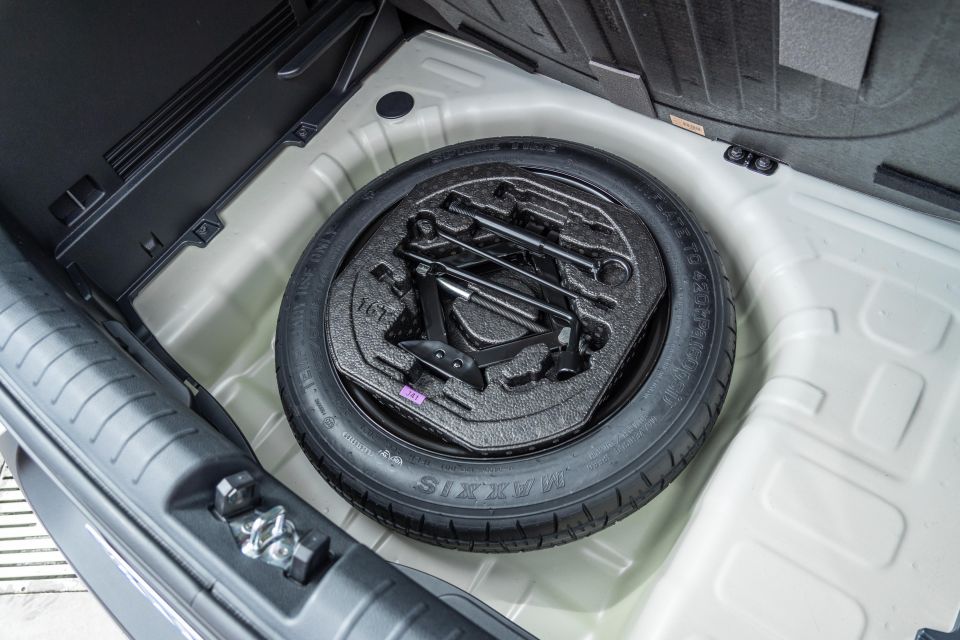
Boot capacity is quoted at 332L with five seats in use, which expands to a more accommodating 1132L with them folded.
Unlike the Puma, there’s no adjustable floor to even out the step between the boot floor and seat backs, despite there being cutouts for one – clearly this feature is offered in other markets.
There’s a space-saver spare wheel under the boot floor, but not any real storage like there is in the Ford.
So the Stonic is more practical, but the Puma is more nicely finished – shall we call this one a tie?
| Ford Puma | Kia Stonic | |
|---|---|---|
| Length | 4207mm | 4140mm |
| Width | 1805mm | 1760mm |
| Height | 1548mm | 1520mm |
| Wheelbase | 2588mm | 2580mm |
| Boot | 410L | 332L |
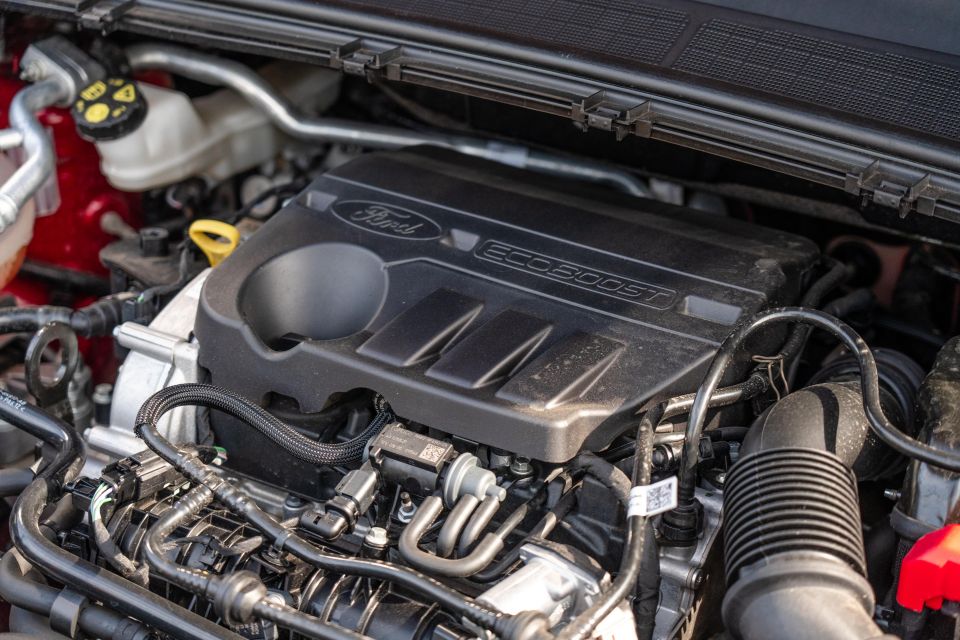
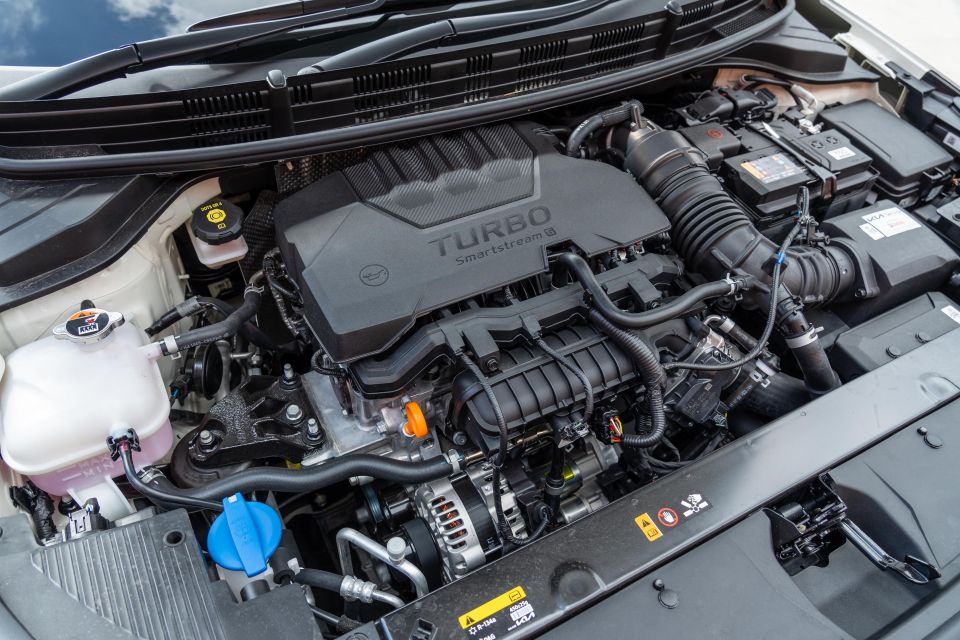
Both vehicles here are powered by 1.0-litre turbocharged three-cylinder petrol engines teamed with seven-speed dual-clutch automatic transmissions driving the front wheels.
The Kia’s three-pot is the lesser unit here at least in terms of outputs, quoting 74kW (6000rpm) and 172Nm (1500-4000rpm). The Ford, meanwhile, has more power (92kW at 6000rpm) but less torque (170Nm at 1400-4500rpm).
Both claim similar combined fuel consumption figures (5.4L/100km Kia v 5.3L/100km Ford), with both featuring idle stop/start technology. Ford and Kia offer 48V mild-hybrid versions of their engines overseas, but not in Australia.
A key difference between the two powertrains is that the Kia’s 1.0 T-GDi unit can run on cheaper 91 RON unleaded in its 45-litre fuel tank, while the Puma’s 1.0L EcoBoost engine requires 95 RON premium juice. The Ford also quotes a slightly smaller 42L capacity for its fuel tank.
| Ford Puma | Kia Stonic | |
|---|---|---|
| Engine | 1.0 turbo-petrol 3-cyl | 1.0 turbo-petrol 3-cyl |
| Fuel economy | 5.3L/100km 91 RON | 5.4L/100km 91 RON |
| Power | 92kW @ 6000rpm | 74kW @ 6000rpm |
| Torque | 170Nm @ 1400rpm | 172Nm @ 1500rpm |
| Transmission | 7-DCT | 7-DCT |
| Driven wheels | Front | Front |
| Weight | 1267kg tare | 1227kg tare |
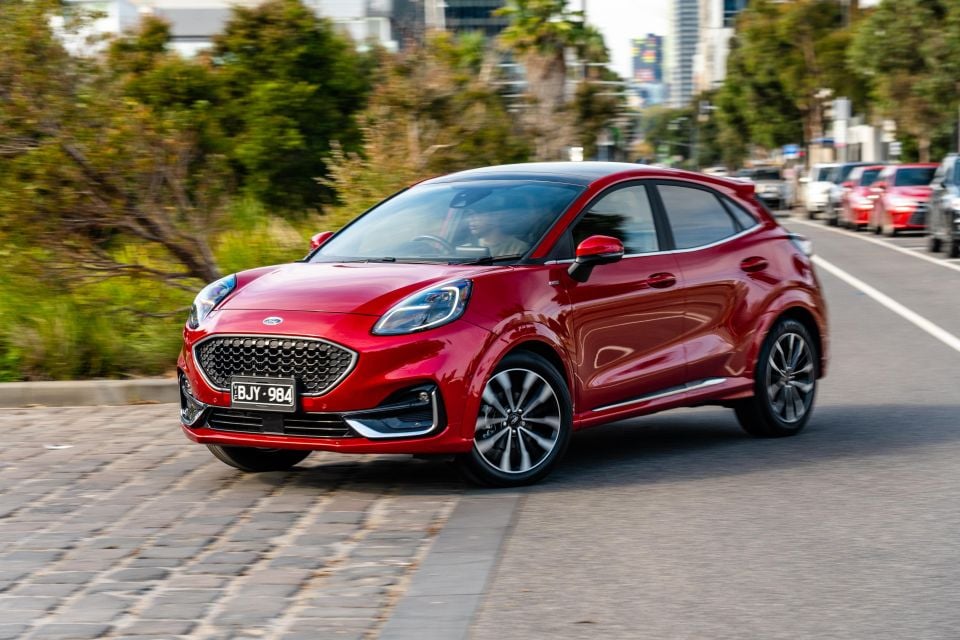
Ford Puma
Regardless of whether you’re driving the top-spec ST-Line V or the entry level ‘Puma’, the little Ford is arguably the best sub-compact crossover to drive.
While the tall, skinny feel of the body and interior gives off a more SUV-like vibe, the way the Puma performs and handles is more sporty hatchback. I’d go as far to say this is how the BMW X1 and X2should feel to drive.
The engine specs of the Ford and Kia might be similar on paper, but they couldn’t be more different in personality. The Ford is eager, responsive and athletic in just about every metric, whereas the Kia takes a more relaxed approach presumably geared towards efficiency.
A seven-speed dual-clutch transmission may ring alarm bells to those that see the low engine outputs and perhaps have heard the stories of Ford Powershift transmissions of old, but the Puma’s seven-speeder is a sweet unit that’s about as close to a standard automatic as you can get this side of a Porsche PDK. The only other DCT I can think of that behaves similarly is the excellent unit used by BMW and Mini in lower-grade models.
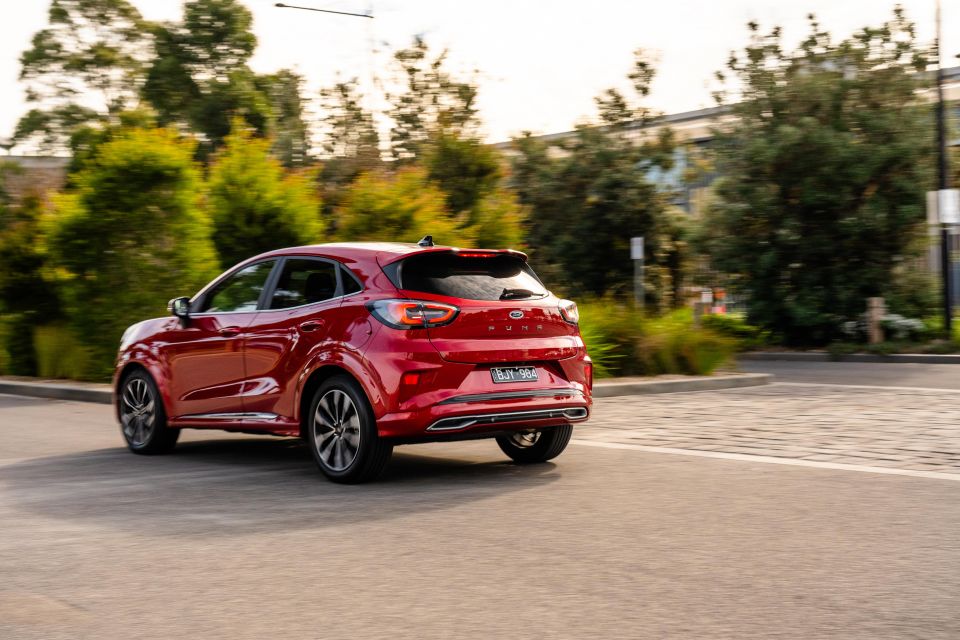
Throttle response is nigh on immediate and the 1.0-litre turbo has a gravelly thrum that’s characterful and refined, and while Ford doesn’t quote an official 0-100 time for Australian models, the mild-hybrid version of the same engine in the UK claims to complete the benchmark sprint in 9.6 seconds and we’d wager that feels about right by the seat of the pants.
I personally love the Puma’s steering feel, it’s quick and responsive off-centre and there’s a very direct feel that’s almost go-kart-like. The steering goes a long way to make the Puma feel tangibly more sporty than its rivals, including the Kia Stonic, and for those wanting an engaging drive but have to ‘compromise’ by getting a crossover, the Ford is a gem.
The ST-Line V retains the ST-Line’s sports suspension, which gets specially-tuned springs and shock absorbers for a more athletic feel, but it never feels uncomfortable like some sport line appearance packages without adaptive damping.
Yes, the more sporting focus is evident in the firmer spring rates and tight body control, but Ford has dialled in a level of usability and balance that means it won’t break your back over tram tracks and pimpled city streets.
On the freeway the Ford’s European DNA really shines through, with the Puma being one of the more planted and confident little crossovers at speed, not just in terms of road holding but also the drivetrain, which happily settles into seventh and hums along nicely. You can imagine these easily sitting at 160-180km/h on the German Autobahn.

Insulation from road and wind noise won’t worry a larger passenger car – like a Focus, for example – but relative to the Stonic and the wider Light SUV segment it’s above average. Rougher surfaces will make the cabin a little echoey, though.
The optional driver assistance features fitted to our test car probably should be standard at the ST-Line V level, but they’re again welcome inclusions that help to give the Puma more big-car abilities on the open road.
Adaptive cruise control with active lane centring accelerates, brakes and assists with steering on the highway, taking the load of longer stints, and the included blind-spot monitoring feature is always handy to have.
The Park Pack’s front parking sensors are also a valuable inclusion, helping when parking nose-in, and it also assists with the semi-autonomous active park assist feature if you don’t want to park the Puma yourself.
All told, the Puma really shines from behind the wheel, and continues to be one of our favourite Light SUVs to drive.
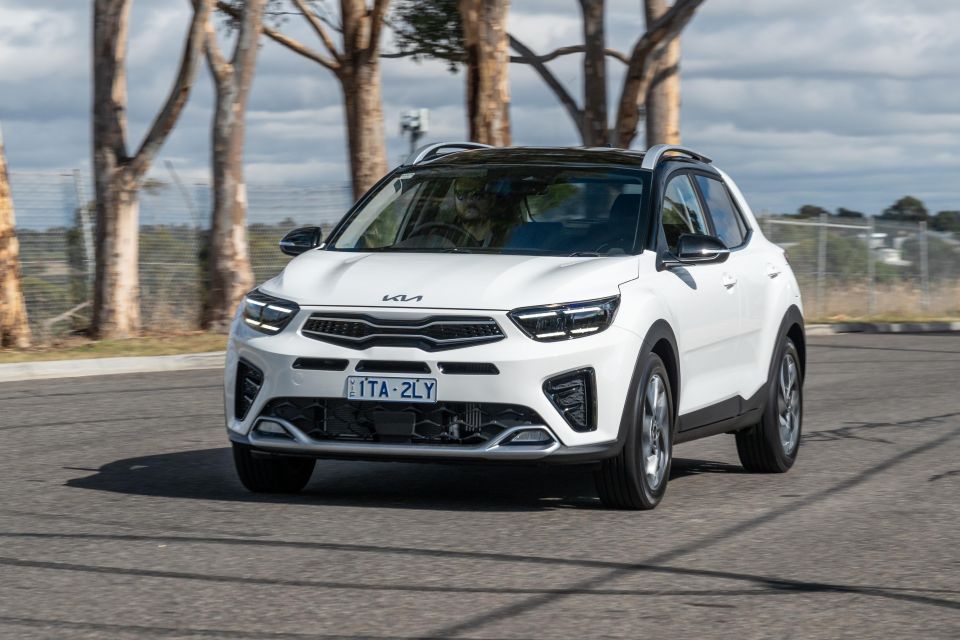
Kia Stonic
The GT-Line version of the Stonic may be wearing an assortment of sporty styling enhancements, but its feel on the road is much more focused on comfort and efficiency compared to the athletic Puma.
From the moment you set off (in default Eco mode, weirdly), the Stonic’s doughy throttle response, light controls and muted engine note is less engaging, but some might prefer the more relaxed vibe.
Like the Ford, the Kia’s 1.0-litre turbo has a thrummy note to it, but the Kia’s is a little more rattly and harsh if you really boot it. Further, the seven-speed dual-clutch auto doesn’t feel as eager to get going off the line (especially after firing up after the idle start/stop system has been engaged), and it hunts for high gears much earlier in the name of efficiency.
Kia Australia doesn’t quote a 0-100 time for the turbocharged Stonic, though overseas specifications serve as a guide. The brand’s UK website says this 74kW 1.0 T-GDi with seven-speed DCT accelerates from 0-100 in 11.7 seconds, which really shows the difference in urgency between the two vehicles we have here – there’s 2.0 seconds difference!
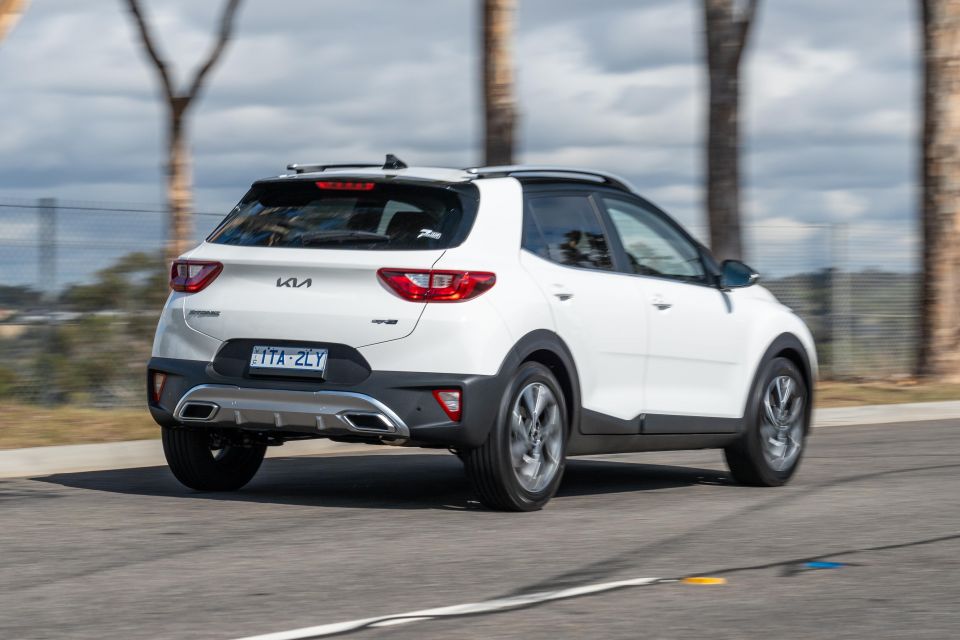
At city speeds though, the Stonic’s little triple offers ample torque to get up to signed speed limits without stress, and 100km/h isn’t a total chore to reach either. Once at triple figures, like the Ford, the Stonic settles into seventh at around 2250rpm and happily putts along.
One thing the Stonic benefits from that the Puma doesn’t is a local suspension tune, something Kia’s Australian division has prided itself on for some time. The GT-Line gets a different tune to the S and Sport versions of the Stonic, to be a little more in line with the sportier branding.
The Stonic balances ride comfort with dynamic ability quite well, and is noticeably softer than the Ford while also still having a good level of body control in corners – though occasionally the torsion beam rear end is a little sharp and boomy over bigger hits. Likewise the steering is a lot lighter than the Ford’s and isn’t as quick, but it’s still accurate and progressive making it a nice, fluid thing to steer.
Such is the chassis’s competence that you’re left wanting for a more substantial powertrain. Pity Kia doesn’t offer the beefier 88kW/200Nm tune of the 1.0 T-GDi anymore, given it’s solely available with expensive 48V mild-hybrid tech globally. The extra grunt could go a long way, though, as it shaves off a second from the UK model’s 0-100 claim.
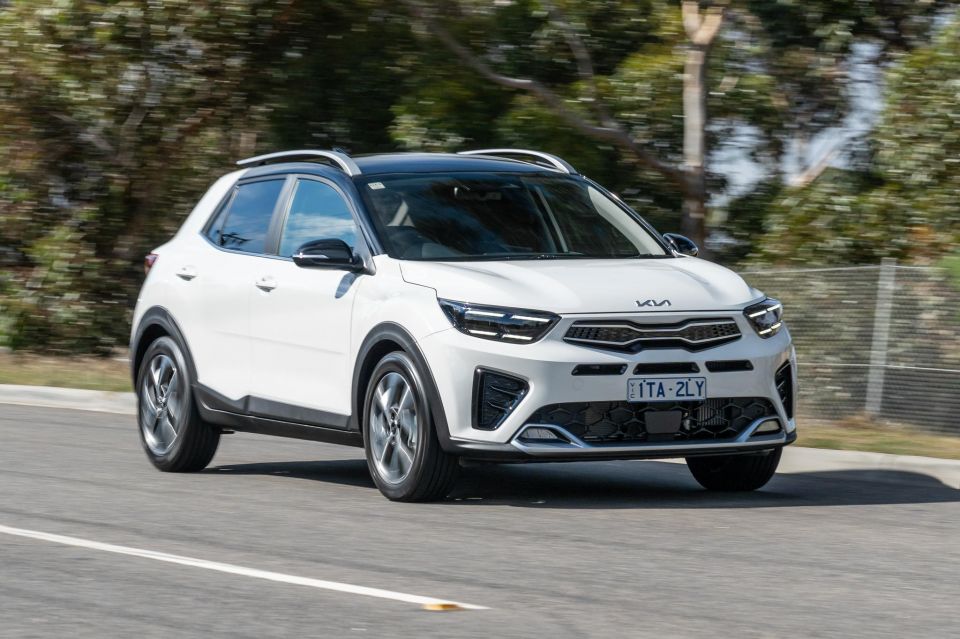
Speaking of things we miss out on in the Australian model, locally-delivered Stonics don’t get a range of driver assistance systems offered in the European spec.
Were we to get the same available features as say, Europe and the UK, the Stonic could match the Ford Puma’s available adaptive cruise control, blind-spot monitoring and rear cross-traffic alert. Alas no, it’s off the menu for us.
Yes the Stonic asks for substantially less than the Puma, though other rivals such as the Toyota Yaris Cross offer a full gamut of assistance features which essentially facilitate semi-autonomous highway driving across the range. Plus, a similarly-priced Kia Cerato offers these features.
The little Kia puts in a solid effort, but it’s outclassed by the Ford here.

The seven-year, unlimited-kilometre warranty offered by the Korean brand outdoes Ford’s five-year, unlimited-kilometre cover by a whole 24 months.
The Puma claws some ground back in terms of servicing and maintenance.
Intervals for the Ford are 12 months or 15,000 kilometres, whichever comes first. The Kia only allows for 10,000km between scheduled visits.

Further, Ford’s capped-price service program is much more consistent and affordable, with each visit costing $299 for the first four years or 60,000km. It them jumps to $320 for the fifth year $370 for the sixth and then $320 again for the seventh – totalling $2206 for the first seven years or 105,000km of ownership.
The Kia, meanwhile, quotes $283, $484, $338, $719, $319, $602 and $569 for the first seven services, coming to a total of $3314 for the first seven years or 70,000 kilometres. Ouch.
Real-world fuel consumption was pretty similar for both vehicles, showing mid-sixes in mixed driving conditions. The Kia takes the edge in the fuel stakes given it has a larger tank and will run on cheaper 91 RON.
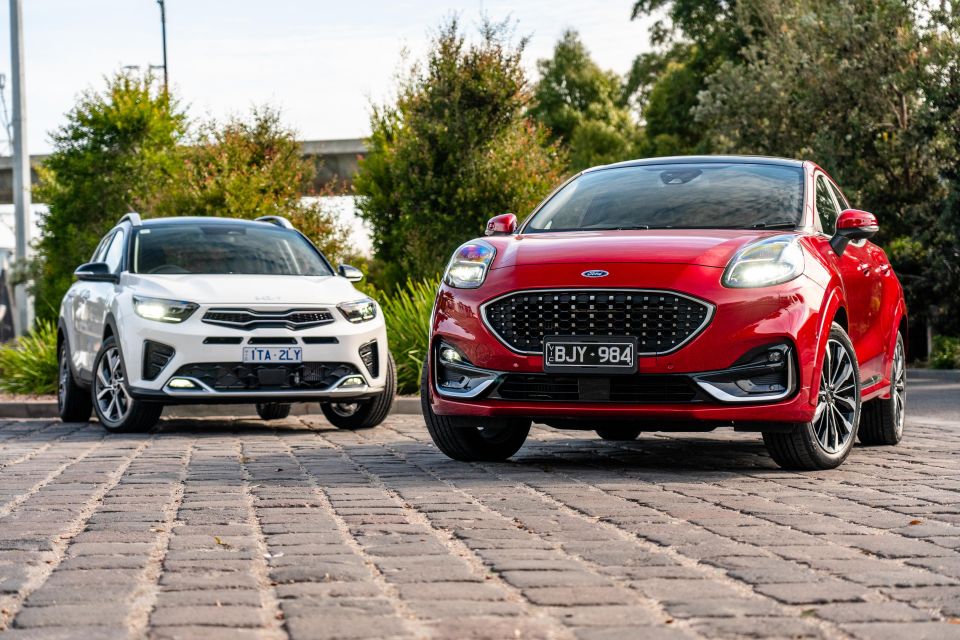
This one is a tough call, while the Ford Puma is fundamentally a better vehicle, its significant price premium over the Kia Stonic cancels out its advantage.
We love the Puma’s sharp dynamics, upmarket cabin trimmings and tech, as well as the available driver assistance systems which give this little crossover an added layer of open-road capability.
European Fords are criminally overlooked in Australia, and the Puma – like its Escape stablemate – deserves to find many more homes Down Under than it currently is.

That said, the Kia Stonic is a solid proposition on its own merits and definitely not a $12,000 worse off vehicle once you factor in on-road costs. It’s also more spacious than the Ford and offers longer warranty coverage.
Looks are subjective, but I also think the Kia’s design appeals to a wider audience, rather than the polarising frog-like face of the Ford – personally I’m a fan of both, but that’s not the point.
So with that in mind, the winner of this comparison is the Kia Stonic GT-Line by the hairs of its chinny chin chin. The base Puma FWD or mid-spec ST-Line with Park Pack would likely leapfrog the Korean, but the decked-out ST-Line V flagship just asks for too much more.
Click the images for the full gallery
MORE: Everything Ford Puma MORE: Everything Kia Stonic
Share your thoughts with us in the comments below!
James Wong is an automotive journalist and former PR consultant, recognised among Australia’s most prolific motoring writers.
Share your thoughts and write a review of a car you own and get featured on CarExpert.


Matt Campbell
3 Hours Ago


William Stopford
19 Hours Ago


Josh Nevett
20 Hours Ago


Ben Zachariah
2 Days Ago


CarExpert.com.au
2 Days Ago


Damion Smy
2 Days Ago